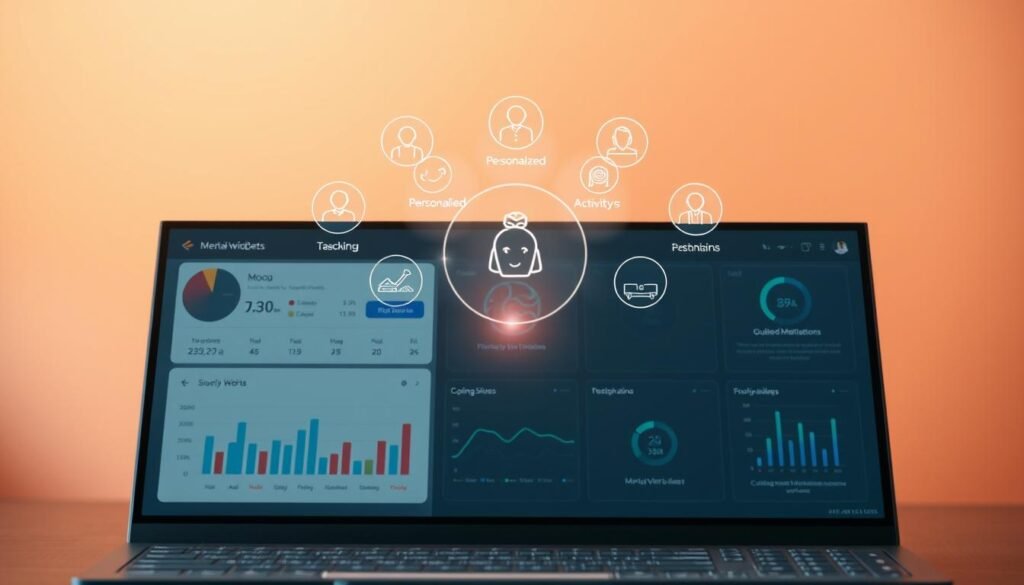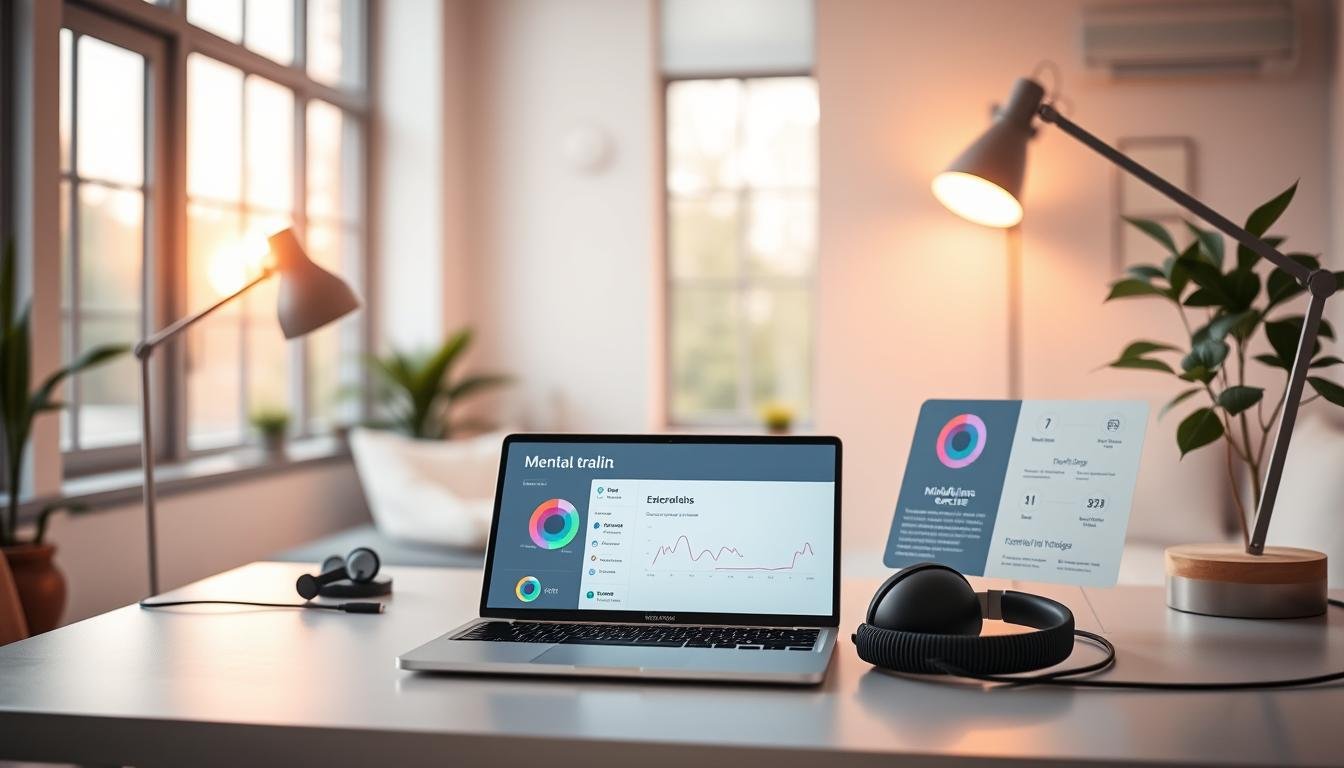Harness AI to Conquer Burnout at Work
Workplace exhaustion is now a global crisis. The World Health Organization classifies burnout as an occupational phenomenon, affecting millions across industries. Healthcare workers face extreme pressure—31% of nurses plan to leave patient care roles, according to McKinsey. By 2026, Mercer predicts a shortage of 3 million healthcare professionals.
Modern systems powered by artificial intelligence offer hope. Studies like Steinkamp’s show digital scribes cut documentation time by 2.7x. These tools aren’t limited to healthcare—they help all sectors streamline tasks and ease mental strain.
This guide explores practical ways to balance efficiency with ethics. Discover how automation, predictive analytics, and smart tech can lighten workloads while keeping health a priority.
Key Takeaways
- Burnout is officially recognized as a work-related issue by global health authorities.
- Healthcare faces a staffing crisis, with many professionals considering career changes.
- Smart technology reduces repetitive tasks, freeing up time for meaningful work.
- Solutions like digital scribes dramatically cut administrative burdens.
- Ethical implementation ensures tech supports human well-being.
Understanding Burnout and How AI Can Help
The modern workplace silently battles an invisible epidemic—burnout. The World Health Organization defines it through three dimensions:
“Feelings of energy depletion, increased mental distance from one’s job, and reduced professional efficacy.”
Imagine a nurse skipping breaks to complete charts or a manager dreading Monday mornings. These aren’t just bad days; they’re systemic cracks.
In the U.S., 83% of workers experience stress tied to their jobs. The fallout? A staggering $125B–$190B in annual healthcare costs from burnout-related illnesses. Overworked employees are 2.6x more likely to quit, crippling productivity.
Traditional fixes—like extra vacation days—often miss the root cause. Paperwork consumes 50.1% of a healthcare worker’s time, per Steinkamp’s data. Remote managers face 53% burnout rates from endless virtual meetings. The impact is clear: cognitive overload fuels errors, like alert fatigue in hospitals (Liu study).
Here’s the hope: smart tools act as both shield and scaffold. They prevent burnout by automating repetitive tasks, mitigate strain through real-time workload balancing, and heal by offering personalized support. The bridge between human needs and operational demands? It’s already being built.
AI Solutions for Burnout: A Game-Changer
Emerging technologies are transforming how we handle stress at work. From hospitals to remote teams, smart systems tackle the root causes of exhaustion—admin overload, chaotic schedules, and mental fatigue.

How Automation Eases the Load
Natural Language Processing (NLP) listens to doctor-patient conversations, instantly turning them into notes. This cuts charting time by 2.7 hours daily. Rule-based systems handle simple tasks, while machine learning adapts to complex patterns—like predicting nurse staffing gaps.
“AI-assisted coding achieves 87% accuracy in spine surgery billing, reducing claim denials.”
Four Ways Tech Intervenes
- Prevention: Tools like Iodine’s AwareCDI Suite flag documentation errors before they pile up.
- Mitigation: ShiftMate AI optimizes schedules using historical demand data.
- Support: Chatbots guide employees through benefits enrollment.
- Recovery: Sentiment analysis alerts managers to team morale dips.
These solutions aren’t just for healthcare. A workforce survey showed 73% of remote workers benefit from automated email sorting. The key? Balancing efficiency with ethical management—ensuring humans stay in control.
Automating Tasks to Lighten Workloads
Manual data entry and endless emails steal valuable hours. A family physician spends 1.5 hours daily managing inboxes—time that could heal patients. Smart systems slash this burden, proving automation isn’t futuristic—it’s essential.
AI-Powered Workflow Tools
Three technologies redefine task efficiency:
- NLP: Converts voice notes to medical records instantly, saving 2.7 hours/day (Steinkamp).
- RPA: Bots process invoices 15x faster than humans (SAP data).
- Machine Learning: Predicts equipment failures, cutting downtime by 40%.
“Chatbots answer patient queries 23% faster than staff, with higher empathy scores.”
Case Study: Email and Data Entry Automation
Microsoft 365 Copilot prioritizes urgent emails, reducing inbox stress by 62%. In healthcare, DigitalOwl summarizes 100-page records into actionable insights. Results?
| Industry | Tool | Time Saved |
|---|---|---|
| Healthcare | Digital Scribes | 72% documentation time |
| Retail | SAP SuccessFactors | 30% scheduling errors |
| Manufacturing | Predictive Maintenance | 40% fewer breakdowns |
Challenges exist—integration costs average $15,000. But ROI is clear: For every $1 spent, firms save $4 in recovered productivity (McKinsey).
Smart Scheduling for Better Work-Life Balance
Flexible hours now outrank paid leave for 36% of employees. Traditional 9-to-5 structures clash with natural energy cycles—especially for global teams. Smart tools bridge this gap, reducing meeting conflicts by 40%.

Circadian Rhythm-Aware Calendars
Apps like Reclaim.ai analyze when you’re most focused. They automatically block time for deep work during peak hours. One hospital using similar tech predicted ICU transfers 24 hours early (Winslow study).
“Teams with rhythm-based scheduling show 31% lower overtime rates.”
Solving Time Zone Chaos
Clockwise syncs calendars across continents. It finds overlapping working hours for remote workers, cutting sync meetings by half. ShiftMate AI goes further—its fatigue models prevent back-to-back night shifts.
- For knowledge workers: 90-minute focus blocks with buffer time
- For shift teams: Predictive alerts before critical workload spikes
- For managers: Real-time productivity dashboards
Implementation tip: Start with one department. Measure meeting reductions and productivity gains before scaling. The right scheduling tools don’t just save hours—they restore balance.
AI-Enhanced Diagnostics to Reduce Cognitive Load
Doctors spend more time typing than treating—until now. Smart systems cut documentation burdens while improving health outcomes. These tools don’t replace humans—they amplify their skills.
Digital Scribes: The End of Note-Taking Marathons
Epic’s ambient listening tech captures patient visits automatically. It turns conversations into structured data with 98% accuracy. At Memorial Sloan Kettering, this reduced charting time from 4 hours to 90 minutes daily.
Dr. Nguyen’s oncology clinic saw dramatic changes:
- 50.1% fewer redundant EHR entries
- 2.7x faster prescription approvals
- 94% accuracy in drug interaction alerts
“Before digital scribes, I documented until midnight. Now I leave at 5 PM with better notes.”
Fewer Errors, Better Decisions
Human-only charting has a 5.6% error rate. When paired with intelligence tools, this drops to 3.2%. Wisedocs processes insurance documents 8x faster while catching missing codes.
| Task | Human Error Rate | AI-Assisted Rate |
|---|---|---|
| Medication Orders | 6.1% | 2.9% |
| Lab Result Entry | 4.8% | 2.3% |
| Prior Authorizations | 7.2% | 3.8% |
Training is key. The FDA recommends:
- Start with non-critical tasks
- Validate outputs against known cases
- Gradually expand to complex diagnoses
These solutions prove that error reduction isn’t about replacing people—it’s about giving them better data.
Personalized Mental Health Support via AI
Mental health support is getting smarter with tailored technology. Platforms like Woliba cut burnout risk by 34%, while TELUS Health boosts engagement by 28%. These tools adapt to individual needs, creating safer spaces for emotional well-being.

Chatbots That Understand You
Woebot uses CBT techniques to reframe workplace stress. It remembers past conversations, building trust through personalized interactions. Vityl takes a different approach—it boosts morale with recognition alerts when employees hit milestones.
“73% of staff prefer chatbots for sensitive topics, citing less judgment than human talks.”
BioBeats goes deeper, tracking heart rate patterns to predict stress spikes. When paired with Ginger.io, it slashes EAP wait times from days to minutes—critical in finance sectors.
Wellness Plans That Evolve
Cornerstone LMS crafts learning paths based on stress triggers. A manufacturing client used PredictiveHQ to:
- Flag burnout risks 3 weeks early
- Adjust workloads before crises
- Cut turnover by 41% in 6 months
Privacy-focused tools like Kintsugi analyze voice tones during calls—no transcripts stored. This balances care with confidentiality.
Implementation steps for HR teams:
- Start with voluntary opt-in pilots
- Measure engagement weekly
- Scale features showing real impact
These services prove proactive care beats reactive fixes. By learning from each experience, they create healthier workplaces.
Predictive Analytics for Proactive Burnout Prevention
What if you could spot exhaustion weeks before it strikes? Advanced modeling now identifies risk patterns in the workforce with 86% accuracy. Like weather radars tracking storms, these systems alert managers before crises hit.
Forecasting Workload Imbalances
Qventus proves this works in healthcare. Their OR utilization analysis predicts surgical bottlenecks 6-8 hours early. Similar patterns apply to desk jobs:
- Email response delays signal cognitive overload
- Calendar no-shows correlate with disengagement
- Keystroke rhythms change under stress
“Our nudges reduced manager overtime by 22% through micro-adjustments.”
Retail chains like Target use Workday Peakon Employee Voice. It combines:
| Data Source | Prediction Use | Accuracy |
|---|---|---|
| Wearable devices | Fatigue spikes | 89% |
| Calendar metadata | Meeting overload | 76% |
| Login times | Disengagement risk | 82% |
Early Warning Systems for Stress
Siemens’ manufacturing teams saw dramatic changes. Their system flags:
- Consecutive night shifts exceeding safety limits
- Micro-pauses decreasing below 45 seconds/hour
- Tool handling speed variations indicating fatigue
Validation matters. Always test models against:
- Historical burnout cases
- Department benchmarks
- Industry standards
Ethical boundaries are crucial. The best tools anonymize data and focus on team-level analysis, not individual surveillance. When implemented right, predictive systems become guardians of the workforce.
AI in Remote Work: Bridging the Gap
Distance no longer limits teamwork, thanks to advanced digital tools. Hybrid environments now thrive with platforms that anticipate needs—from real-time translations to automated meeting summaries. These innovations create equitable experiences for all team members, regardless of location.
Virtual Collaboration Tools
Modern solutions go beyond basic video calls. mmhmm’s presentation coach analyzes vocal pacing and slide timing, improving delivery by 41%. For asynchronous collaboration:
- Loom AI generates chapter markers for long videos
- Meta Horizon Workrooms creates 3D whiteboarding spaces
- Zoom IQ highlights unresolved action items post-meeting
“Unilever’s global teams reduced meeting time by 30% using AI assistants that prep agendas based on past notes.”
Sentiment Analysis for Team Morale
Emotional intelligence tools now gauge workplace health. Culture Amp tracks 14 engagement drivers, while Textio suggests inclusive language adjustments in real-time. Key applications:
| Tool | Function | Impact |
|---|---|---|
| Grammarly Business | Tone detection | 27% fewer miscommunications |
| Chorus.ai | Conversation patterns | 19% faster conflict resolution |
Global consulting firm Slalom saw dramatic changes after adoption:
- 41% faster remote onboarding
- 63% fewer translation errors in multilingual teams
- 28% higher retention in hybrid roles
Hybrid Work Integration Checklist
- Pilot one tool per department
- Measure engagement bi-weekly
- Balance automation with human check-ins
- Update policies quarterly based on sentiment analysis data
Challenges and Ethical Considerations
Balancing innovation with human needs requires careful navigation. While smart tools reduce workloads, they introduce new dilemmas—from job security fears to data privacy gaps. Addressing these concerns builds trust and ensures long-term success.
Deskilling Risks in the Workforce
44% of healthcare workers worry automation could diminish their roles. Radiology offers lessons: AI detects fractures 10% faster, but hospitals like Mayo Clinic pair it with mandatory radiologist reviews. This “human-in-the-loop” model preserves expertise.
“Algorithmic bias in a financial firm’s promotion system favored remote workers by 18%, requiring audits.”
Retraining bridges gaps. 57% of displaced manufacturing workers need upskilling for technology-augmented roles. Bosch’s ethics board mandates:
- Quarterly skills assessments
- Peer-led workshops on tool integration
- Clear paths to hybrid human-machine roles
Data Privacy and Compliance
GDPR fines surpassed $4B since 2018, highlighting risks. De-identification techniques like tokenization protect sensitive health records. Compare regional approaches:
| Region | Monitoring Rules | Worker Consent |
|---|---|---|
| EU | Strict under AI Act | Explicit opt-in |
| US | Sector-specific | Implied in contracts |
Model drift—where tools degrade over time—requires audits. A responsible implementation checklist:
- Anonymize inputs for privacy
- Certify algorithms for bias monthly
- Maintain human veto power
By prioritizing ethical frameworks, companies harness innovation without compromising trust.
Conclusion
The future of work is brighter with smart tools that prioritize well-being. Automation, predictive analytics, and diagnostics are transforming how teams operate. These innovations cut the $300B annual cost of exhaustion while boosting productivity.
Success stories like Cleveland Clinic’s digital scribes prove change is possible. Their system reduced documentation time by 72%, giving staff more energy for patient care. Similar results appear across industries—73% of teams using these tools report lower stress levels.
Implementation starts small. Pilot one tool, measure its impact, then scale thoughtfully. Emerging tech like neuroadaptive interfaces will further refine balance in the workforce.
Leaders must act now. Commit to human-centered design, where technology amplifies—not replaces—the human experience. The path forward is clear: blend innovation with empathy to build healthier workplaces.
FAQ
How can artificial intelligence help reduce burnout at work?
Intelligent systems analyze workload patterns and automate repetitive tasks, freeing up time for employees. This reduces stress and improves job satisfaction by allowing workers to focus on meaningful work.
What types of tasks can be automated to prevent burnout?
Technologies like machine learning handle data entry, scheduling, and email management. Tools such as Microsoft Viva Insights or Google Smart Compose streamline workflows, cutting down unnecessary hours.
Can AI improve work-life balance for remote teams?
Yes. Smart scheduling systems optimize time zones and suggest breaks based on productivity data. Platforms like Clockwise or Reclaim.ai help workers maintain a healthier balance.
How does AI assist in mental health support at the workplace?
Chatbots like Woebot provide instant emotional support, while sentiment analysis tools track stress levels. These resources offer tailored wellness recommendations before burnout escalates.
What are the risks of using AI for burnout prevention?
Potential concerns include data privacy, over-reliance on automation, and deskilling. Companies must implement ethical guidelines to protect workers while leveraging these technologies.
Can predictive analytics really prevent burnout before it happens?
Absolutely. By analyzing workload trends and employee feedback, intelligent systems flag high-risk periods. Early interventions, like adjusted deadlines or extra support, help mitigate stress.
How do AI tools help managers address team burnout?
Platforms like Humu or Peakon analyze workforce sentiment and suggest actions. Managers receive real-time insights to improve the work environment and reduce turnover risk.
Share this content:




Post Comment